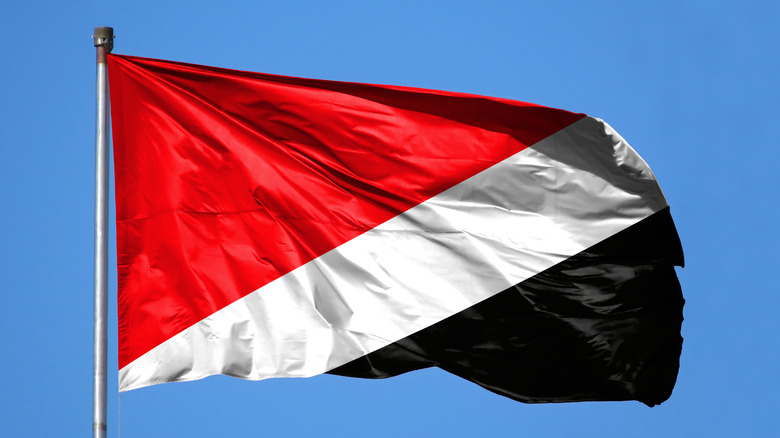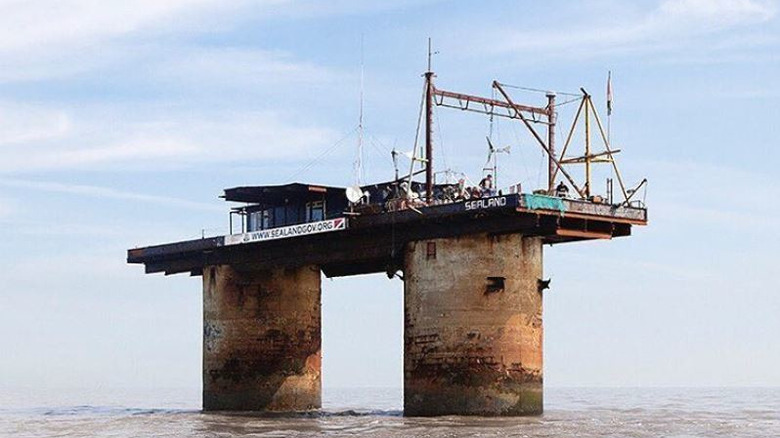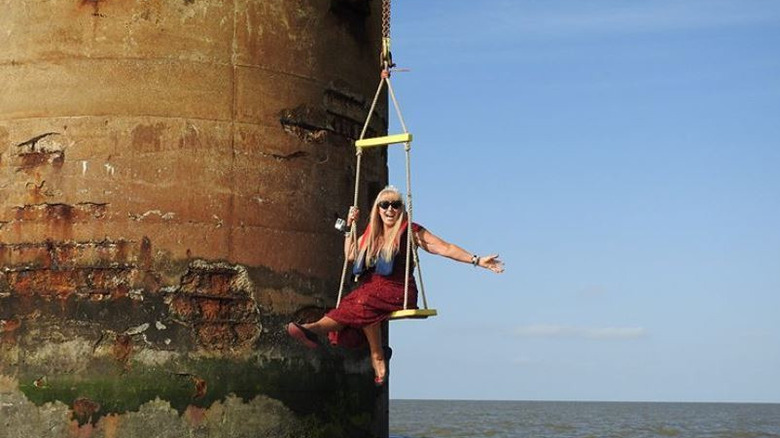You'll Need Special Clearance If You Want To Visit The World's Smallest Country/Micronation
Traveling the world offers an almost inexhaustible supply of unique experiences, and when you've run out of official countries to visit, you can turn your attention to micronations. One such internationally unrecognized state lies just off the U.K. coast, and it is pretty bizarre even by the standards of its fellow self-declared countries: The Principality of Sealand. You won't find it on Google Maps but it is definitely there – in sight of the nation that first built it, decommissioned it, and later denounced it — around seven miles out to sea from the Suffolk shore.
A glance at Sealand forces one to reconsider what a country is. There is no actual land because it is a repurposed World War II fort: two nearly 60-foot-tall concrete cylinders supporting a steel platform and a helicopter pad, jutting out of the North Sea. It is in the Guinness Book of Records as the smallest area to declare itself a nation, at just under 14,000 square feet. Its population is similarly diminutive: although Sealand officially has over 300 citizens, the fort itself only has one permanent resident.
Befitting a buccaneering past in which its occupants have thwarted invaders, a coup, and even the British Royal Navy, Sealand is very hard to visit. Approval for a visa requires a lengthy evaluation process from the micronation's Bureau of Internal Affairs and the government website warns that acceptance is highly unlikely. However, if you are lucky enough to secure a visa, you will become a member of a select club who have had the opportunity to experience this unique place for themselves.
Sealand has a remarkable history
The Principality of Sealand started life as HM Fort Roughs, constructed during the Second World War off the U.K.'s coast to ward off German aircraft. The fort was decommissioned in the '50s but got a new lease of life in the era of pirate radio. In the '60s, intrepid radio stations would set up makeshift studios offshore to skirt broadcasting regulations. In 1966, Major Paddy Roy Bates planned to move his station, Radio Essex, from an old sea fort within the jurisdiction of the U.K. to Roughs Tower, which then lay in international waters. The station never took off but Bates conjured a grander plan: On his wife's birthday, September 2, 1967, he declared independence and crowned himself and his spouse Prince and Princess of the Principality of Sealand.
According to Sealand's official website, Sealand has thwarted several invasion attempts with guns and petrol bombs, including from the British Navy. One of the most critical moments came in 1978 when German and Dutch mercenaries seized control of Sealand and held Prince Roy's son, Michael, hostage for several days. After his release, he wrested back control of the fort and held the invaders prisoner. Perhaps understandably, the fight to remain independent has made the Sealanders a little paranoid — in 1990, shots were fired across the bow of a ship that ventured too close.
Visiting Sealand is rare but totally unique
Despite its size, Sealand has all the trappings of a legitimate state. It has a royal family, national anthem, flag, currency, constitution, passport control, and even an international soccer team, albeit one that is not recognized by FIFA or UEFA. And while visiting Sealand is difficult, Prince Michael has welcomed groups of extreme travelers, influencers, and large media outlets such as CBS's "60 Minutes" in recent years. Nowadays, you can even buy official titles: Baron von Edward Sheeran, better known as international pop star Ed Sheeran, is Sealand's most high-profile noble.
Even arriving in the principality is unconventional. Unless you can spring for a helicopter rental, it's a short boat ride from the Suffolk coast, followed by a hair-raising ascent to the platform on a rope swing. The tour includes a visit to passport control, where you will get a very rare Sealand stamp, and a chance to check out the fort's royal bedroom, cathedral, and even the prison, situated below the waterline at the base of one of the concrete pillars.
Living on Sealand has always been a very spartan existence, a basic lifestyle where adventurous spirits make the most of what they have in a very unusual environment. Nowadays, the principality has a strong online presence but otherwise relies on self-sufficiency to make life bearable, filtering rainwater and using solar panels and wind turbines for electricity. E Mare Libertas, as the Sealand motto says: From the sea, freedom.


